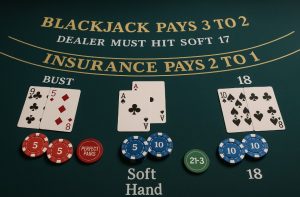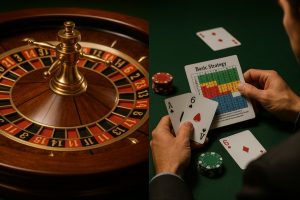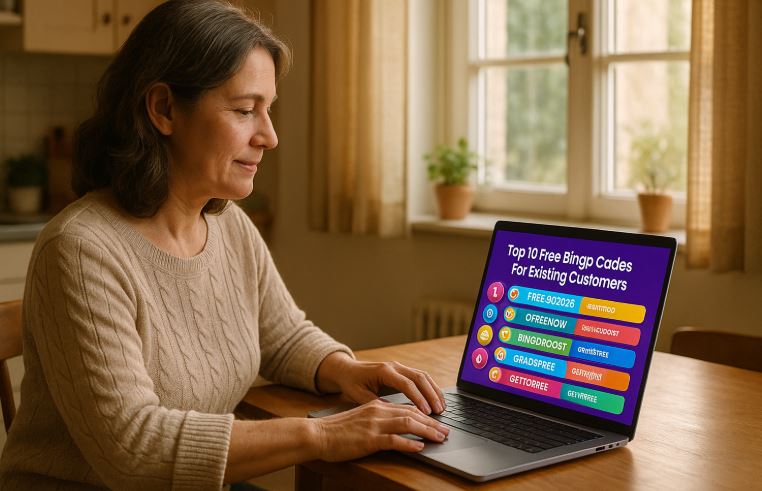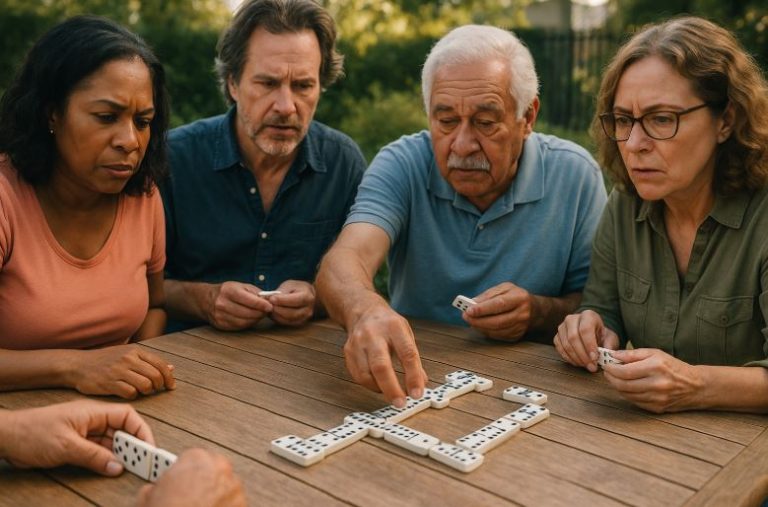Rules of Blackjack Card Game (21 Card Game) | Gameplay, Setup and Strategies
Blackjack, also known as the 21 card game, remains a staple in casinos around the world, especially in the UK. Understanding the rules of blackjack card game is essential for both beginners and seasoned players.
This guide provides a comprehensive overview of how the game is played, its setup, and effective strategies for improving your chances.
Whether at a live casino or online table, knowing the rules and making informed decisions can enhance your overall experience and success.
What Are the Basic Rules of Blackjack Card Game?

Blackjack, or 21, is a comparing card game played between one or more players and a dealer. Each player competes against the dealer but not against other players. The core objective is to have a hand value closer to 21 than the dealer’s hand, without exceeding 21.
Each player is dealt two cards at the beginning of the round, and so is the dealer. Players’ cards are usually dealt face up, while the dealer receives one card face up and one face down.
Cards 2 through 10 are worth their face value, face cards (Jack, Queen, King) are each worth 10 points, and Aces are valued at either 1 or 11, depending on which is more beneficial to the hand.
A two-card total of 21 consisting of an Ace and a 10-point card is called a “blackjack” and is the strongest possible hand.
If the dealer also has blackjack, the hand results in a tie (push). Otherwise, the player with blackjack wins instantly and typically receives a payout of 3:2.
Players then have the option to continue drawing cards or stand, and the dealer must play according to pre-set rules (typically drawing until reaching a total of 17 or higher).
How to Play Blackjack or 21 Card Game?

The gameplay of blackjack, particularly in a traditional 6-deck or 8-deck shoe game, follows a structured sequence designed to ensure fairness and clarity for both players and the house.
Whether played in a brick-and-mortar UK casino or online, the basic structure of a round remains largely the same.
Buying Chips
Before participating in a hand, a player must exchange cash for chips. In physical casinos, this involves laying cash directly on the table. For security reasons, players must not hand money directly to the dealer.
The dealer will then arrange the money clearly on the felt so that it is visible to surveillance cameras, and a pit boss will verify the amount.
Once confirmed, the dealer provides chips equivalent to the amount paid, and the player can begin placing bets.
Most casinos do not accept cash wagers directly on the table, so acquiring chips is a mandatory first step before engaging in any gameplay.
Placing a Wager
Once in possession of chips, the player places a bet in the designated betting area on the table. This could be a circle, square, or an emblem of the casino, depending on the table design.
Betting limits are displayed on a small placard on the table, outlining the minimum and maximum allowable bets. These limits can vary significantly depending on the venue and its regulations.
Dealing the Cards
After bets are placed, the dealer begins the dealing process, which occurs in a clockwise direction. Each player receives one card face up, followed by the dealer receiving one card face down.
This is then repeated so that all players have two cards face up and the dealer has one card up and one card down.
At this stage, the game transitions into the decision-making phase where players must determine how to proceed based on their two-card hand and the dealer’s visible card.
Player Decision Phase
Starting from the dealer’s left (often referred to as “first base”), each player takes their turn to play their hand. The dealer waits for each player to make a decision using hand signals — not verbal instructions — to ensure transparency for casino cameras.
Players evaluate their hands by summing the values of their two cards. If the total equals 21 with an Ace and a 10-point card, it’s an automatic blackjack.
These hands are paid out immediately at 3:2, unless the dealer also has a blackjack, in which case the result is a push (tie).
If no blackjack occurs, players choose how to play their hand using one of the following five options:
- Stand: If content with the total, the player signals to stand by waving their hand or placing an open palm over the felt. The dealer moves to the next player.
- Hit: If the player wants to improve their hand, they tap the felt. The dealer provides additional cards until the player either stands or busts (goes over 21).
- Double Down: For strong starting hands, the player may double their initial bet and receive exactly one more card. The additional wager is placed beside the original bet, and the new card is dealt face up and sideways.
- Split: If dealt two cards of equal value, players may split them into two separate hands. This requires a second bet of equal value. The dealer then deals a second card to each of the new hands, and the player plays them one after the other.
- Surrender: In some casinos, a player can choose to surrender their hand early and reclaim half of their original bet. To do so, they draw a horizontal line behind their chips and verbalise the word “surrender” for clarity.
Once all players have acted, their hands are either final (stood), lost (busted), or partially resolved (doubled, split, or surrendered). Only players with hands still in play proceed to the dealer’s turn.
Dealer’s Turn
After all players have completed their hands, the dealer reveals their hidden card. If the total is 17 or higher, the dealer must stand. If the total is 16 or less, the dealer is required to draw additional cards until reaching at least 17.
A special case is the soft 17, a hand that includes an Ace counted as 11, such as Ace + 6. Depending on the house rules, the dealer may be required to hit or stand on soft 17. This rule can slightly alter the house edge and is usually indicated on the table felt.
Unlike players, dealers are not permitted to make strategic decisions; they must play strictly according to house rules. There is no doubling down, splitting, or surrendering for the dealer.
Payouts and Resolution
With the dealer’s hand complete, the final outcomes are determined. The results depend on whether the dealer has busted or completed a hand of 17–21:
- If the dealer busts, all remaining players with valid hands are paid out at 1:1 (even money).
- If the dealer stands with a hand, comparisons are made:
- Players with a higher hand win and are paid at 1:1.
- Players with a lower hand lose their bets.
- Tied hands result in a push, and the player’s bet is returned.
The round ends with the dealer clearing all cards and chips, and a new round begins with players placing fresh bets.
What Are the Key Terms and Terminologies in Blackjack?

Blackjack has a specialised vocabulary that helps define the gameplay, betting, and strategy:
- Bust: A hand exceeding a total value of 21.
- Push: A tie between the player and dealer, no one wins or loses.
- Blackjack: A two-card 21 consisting of an Ace and a 10-point card.
- Hard Hand: A hand without an Ace or with an Ace valued as 1.
- Soft Hand: A hand containing an Ace counted as 11, which can’t bust with a single card.
- Insurance: A side bet offered when the dealer shows an Ace. It pays 2:1 if the dealer has a blackjack.
- Natural: Another term for a blackjack, a perfect two-card 21.
Learning and understanding these terms is key to improving both strategy and confidence at the table.
What Strategies Help Win at Blackjack?
Winning at blackjack isn’t just about luck strategy plays a pivotal role. Unlike games of pure chance, blackjack allows players to make informed decisions that directly impact outcomes.
Over the years, various techniques and methods have been developed to improve a player’s edge, ranging from foundational systems like basic strategy to more advanced approaches such as advantage play and card counting.
Basic Strategy: The Foundation of Smart Play
At the core of blackjack strategy is the basic strategy, a mathematically derived system that outlines the best way to play every possible hand based on the player’s cards and the dealer’s visible card.
This strategy minimises the house edge and is applicable to most standard blackjack rules, including games played with four to eight decks, where the dealer hits on soft 17, and players are allowed to double after a split.
Basic strategy charts are designed to help players decide when to:
- Hit
- Stand
- Double down
- Split
- Surrender
Here is a simplified version of what the strategy might recommend in a six-deck game:
- Stand on hard totals of 18–21, regardless of the dealer’s card
- Hit on hard 12 against dealer 2–3, but stand if the dealer shows 4–6
- Always double down on a hand total of 11
- Split Aces and 8s, never split 10s
- Never take insurance or “even money”, these are statistically poor choices
By following these guidelines, the player’s expected long-term loss (house edge) can be reduced to around 0.5% to 1%, making blackjack one of the most player-friendly games in the casino.
Composition-Dependent Strategy: Refining the Basics
While basic strategy is based on the total value of the player’s hand and the dealer’s upcard, composition-dependent strategy takes things a step further. It factors in the actual makeup of the player’s hand, not just the total.
For example, consider a hand worth 12 against a dealer’s 4. Basic strategy suggests standing. However, if the 12 is made up of a 10 and a 2 in a single-deck game, hitting may be the better choice. This is because:
- The presence of a 10 reduces the likelihood of drawing another 10 and busting.
- The combination of a 10 and 2 is statistically weaker when standing.
Though the improvements over basic strategy are relatively minor especially in multi-deck games composition-dependent decisions can slightly reduce the house edge further.
Advantage Play: Gaining the Upper Hand
Advantage play refers to legal methods that allow players to gain a statistical edge over the house. These methods rely on memory, observation, and mathematical analysis rather than chance.
Card Counting
Perhaps the most famous form of advantage play, card counting involves keeping track of the cards that have been dealt to estimate the composition of the remaining deck.
The idea is to increase bets and modify decisions when the count is in the player’s favour, typically when more 10s and Aces remain in the shoe.
Card counting systems assign values to different card ranks:
- Low cards (2–6): +1
- Neutral cards (7–9): 0
- High cards (10–Ace): -1
The total, known as the running count, is updated after each card is dealt. Players then convert the running count to a true count by dividing it by the number of remaining decks. This helps determine how favourable the conditions are for increasing bets or deviating from basic strategy.
Though card counting is legal, casinos often take measures against suspected counters. These can include reshuffling the deck more frequently, limiting bets, or asking the player to leave the blackjack tables — or even the property altogether.
Card counting is most effective in single-deck games with deep penetration (i.e., when most of the deck is used before reshuffling), though these conditions are rare in most modern casinos, especially online.
Shuffle Tracking
Shuffle tracking is a more complex method suited to multi-deck games. It involves monitoring clumps or “slugs” of high-value cards during the shuffle, then attempting to track their reintroduction into play.
This technique demands sharp eyesight and a detailed understanding of shuffle mechanics. When successful, players can increase their bets at times when favourable cards are likely to appear. Unlike card counting, shuffle tracking does not rely on the composition of the shoe but on the movement of specific card groups.
The effectiveness of shuffle tracking decreases in games where automatic shuffling machines are used or when casinos perform continuous shuffling.
Hole Carding and Edge Sorting
Players may also attempt to spot the dealer’s face-down card, a method known as hole carding. If the dealer reveals even a sliver of their hidden card during the deal, observant players can adjust their strategy accordingly. This approach is rare and depends on the physical dealing style of the casino staff.
Edge sorting, another controversial method, relies on detecting subtle differences in card backs due to printing defects. It requires careful observation and is typically only feasible in high-stakes games using specially marked cards.
Though these methods are not considered illegal in many jurisdictions, they are often grounds for banning or refusing service to players who are caught employing them.
Promotions and Payout Variations
Casinos occasionally offer promotions that temporarily tilt the odds in the player’s favour. For example, a 2:1 payout on blackjack (instead of the usual 3:2) significantly reduces the house edge.
Complimentary matchplay vouchers, free chips, and cashback offers also present short-term value opportunities for savvy players provided they continue to adhere to basic strategy.
However, it’s important to be cautious of rule changes that disadvantage the player, such as:
- 6:5 blackjack payouts (increasing the house edge)
- No double after split
- Dealer hitting on soft 17
Such conditions can negate the advantages gained from promotions and should be avoided by serious players.
How Are Betting Rules and Payouts Structured in Blackjack?

In blackjack, bets are placed before any cards are dealt. Once the cards are in play, players cannot change their bet amounts except when doubling down or splitting.
The standard payout system is as follows:
- Blackjack pays 3:2
- Winning hand without blackjack pays 1:1
- Insurance win pays 2:1
- Push returns the original bet
- Loss forfeits the bet
Side bets have become increasingly common in modern blackjack tables. While they can offer higher returns, they generally come with a much higher house edge. Examples include “Perfect Pairs,” “21+3,” and “Royal Match.”
Casinos may also offer games with altered payouts, such as 6:5 for blackjack instead of 3:2. These games significantly increase the house edge and are often considered less favourable to players.
How Do Casino Rules Vary in Blackjack Games?
Blackjack is a game of many variations, and different casinos especially across online and land-based formats can impose slightly different rules.
These variations impact the house edge and player strategy. Some of the most common rule differences include:
- Dealer hits or stands on soft 17: If the dealer stands on soft 17, it slightly benefits the player.
- Re-splitting Aces: Some casinos allow players to split Aces multiple times.
- Doubling after split: Rules differ on whether doubling down is allowed after splitting a pair.
- Deck number: Fewer decks typically improve player odds, but single-deck blackjack is rare in UK casinos.
UK online casinos often display their rule sets clearly on each game screen. This allows players to select tables with rules that align with their preferences or strategy.
What Are Common Mistakes to Avoid in Blackjack?
Even players familiar with the rules can fall into patterns that reduce their chances of winning. Understanding and avoiding these mistakes is critical for long-term success.
Some of the most frequent errors include:
- Chasing losses: Increasing bet sizes to recover losses can quickly lead to a depleted bankroll.
- Ignoring basic strategy: Emotion-based decisions often lead to suboptimal outcomes.
- Misusing insurance bets: While tempting, insurance usually does not offer good value.
- Failing to differentiate between hard and soft hands: Misplaying these can lead to unnecessary busts.
By focusing on correct decision-making and discipline, players can improve their results and enjoy the game more consistently.
Can You Play Blackjack Online and What Should You Know?
Yes, blackjack is one of the most popular games available at online casinos in the UK. Online versions offer a convenient and accessible way to play whether through live dealer games or software-based tables.
Live dealer games feature real-time video streams of human dealers, often hosted in studios or actual casinos. Players can interact via chat and place bets on a digital interface.
Digital blackjack, on the other hand, uses random number generators (RNGs) to deal cards instantly and allows for quicker gameplay.
Important considerations when playing online include:
- Ensuring the site is licensed by the UK Gambling Commission
- Checking the Return to Player (RTP) percentage which is typically 98-99% in blackjack
- Understanding any game-specific rules, such as bet limits and available side bets
Many reputable UK casino sites offer demo versions, allowing players to practise strategies before playing for real money.
Is Blackjack a Game of Skill or Luck?

Blackjack stands apart from other casino games because it balances both chance and skill. While the cards are dealt randomly, the outcome can be influenced by player decisions, especially over many hands.
Luck determines which cards appear, but skill guides how a player responds. For example, consistently hitting on 12 when the dealer shows a 2 is a mistake that can cost players in the long term.
Practising good strategy, learning from mistakes, and analysing decisions are all aspects of skill development in blackjack. While no one can control the shuffle, smart play can tip the odds slightly in the player’s favour over time.
Conclusion
Mastering the rules of blackjack card game can greatly enhance your odds and enjoyment at the casino. From understanding the value of each card to learning when to hit, stand or double down, knowledge is key to making smart decisions.
By following proven strategies and avoiding common mistakes, players can confidently approach any table, online or offline. Whether you’re a beginner or aiming to refine your skills, a solid grasp of blackjack rules is your first step to winning more often.
FAQs About the Blackjack Card Game
What is the best hand in blackjack?
The best hand is a natural blackjack, an Ace paired with a 10-point card. It usually pays out at 3:2.
How many decks are used in blackjack?
Blackjack can be played with anywhere from 1 to 8 decks. Most UK casinos use six or eight decks for standard games.
Is card counting legal in UK casinos?
Card counting is not illegal, but most casinos discourage it and may ban players suspected of using it.
Can I split any two cards in blackjack?
You can only split cards of the same value, such as two 8s or two Queens.
What happens if both the player and dealer get blackjack?
The round ends in a push (tie), and the player’s original bet is returned.
Is it better to play blackjack online or in a physical casino?
Both offer pros and cons. Online games are convenient, while land-based casinos provide a more immersive atmosphere.
What is the house edge in blackjack?
With optimal play, the house edge can be as low as 0.5%. Without strategy, it increases significantly.
Disclaimer: UK Casino Site is a blogging platform only. It does not promote or operate gambling services. Please gamble responsibly.







